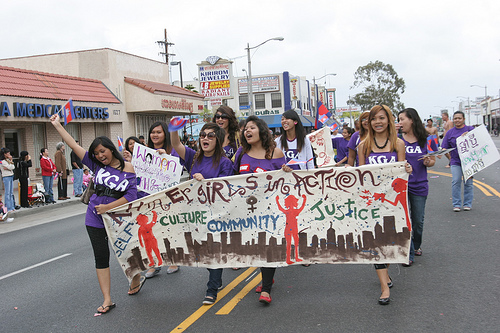
Khmer Girls on the March
Khmer Girls in Action (KGA) empowers young Southeast Asian women with an eye towards individual, political, and cultural transformation.
KGA began its life in 1997 as HOPE for girls, an empowerment-based reproductive health program for young Cambodian (or Khmer) women in Long Beach, CA — the location of the largest Cambodian community in the US. A sexual harassment campaign, sparked by a comment from a school teacher towards on of HOPE’s members, launched the group into the world of organizing. Eventually KGA split off from its parent organization, Asian Pacific islanders for Reproductive Health (APIRH).
Having widened their focus beyond health to include many issues faced by young Southeast Asian women (and now men, with the introduction of the Young Men’s Empowerment Program), KGA combines leadership development, political education, community organizing, and arts and media work to create “gender and culture specific approaches to youth organizing.” In addition to reproductive health, KGA has tackled issues such as police harassment, and making sure Cambodians are fully counted in the 2010 census. Last year they worked with the UCLA Datacenter to survey over 500 Khmer youth about their experiences. The results, which have been written up in a visually creative report, highlight issues of police harassment, disctrimination, sexuality, reproductive health, and mental health. This participatory action research project, followed by a listening tour, has led to the launching of the new Youth at the C.O.R.E. campaign.
KGA’s work targets cultural change in a couple of ways. Internally, as a feminist organization run by young women, KGA youth have engaged with expectations and restrictions on women within the Khmer community. Externally, KGA demands dignity and respect for the Southeast Asian community, which faces discrimination around race and ethnicity, as well as immigration status. And the organization’s recent demands include the need for culturally relevant curriculum in schools that serve Southeast Asian youth.

Tongues Afire Open Mic
The Cultural Historical Arts Program (CHA) serves as the organization’s artistic arm, seeking “to use art as a tool to organize the community around issues that deeply impact people’s lives.” CHA is made up of two distinct pieces. The first is the Tongues Afire workshops, where young women engage in writing and spoken word poetry. This program provides a space for internal reflection and community building, as attested to by the story of Keo Ouk, for whom poetry writing at Tongues Afire was key to dealing with the violent loss of a close friend. It’s also a space of consciousness raising and empowerment, as can be seen in this poem, by Tiffany Min, and published in UCLA’s Amerasia Journal:
Women
They say women are weak
That they can’t defend themselves
That they are wrong
Don’t misunderstand
That we are strong
Strong enough to take care of
Ourselves
And big enough to rule our lives
We live in a shadow
But, we don’t hide ourselves
We struggle, we survive
The second part of CHA is the 3rd Eye Vision Workshop, in which youth utilize video and digital media towards community change. Below is a video created by KGA youth to support the successful 2009 challenge to California’s Proposition 4, a constitutional amendment to mandate parental notification and delayed care for abortion. It combines poetry, music, and video:
To learn more about Khmer Girls in Action, visit their website at http://www.kgalb.org/, and check out this piece at the Orange County Groups Blog.



